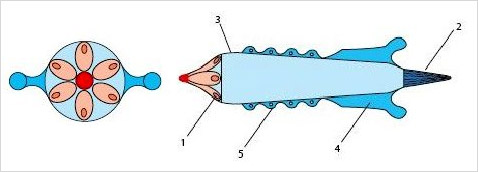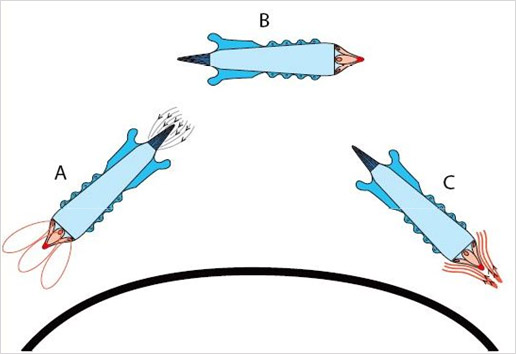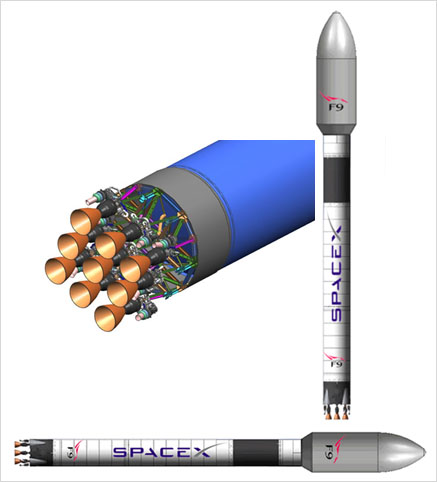Uturn Semantics Cj-2004 Substructures
1. Aerospike propulsion module (ceramic shielded)
|
|
Ascend/reentry hierarchy
Nomenclature: A =Ascending; B =Space (rotation); C =Reentry |
|
Uturn makeup
Since the invention of the liquid rocket engine by Alexander Graham Bell approx 90y ago, the world has been transfixed on the enigma of thunderous blastoffs. The rocket motor however has been factually defective in its making due to 1) kinetic loss 2) fixed expansion envelope 3) impediment of the liquid/cryogenic propellants without a rational offset & 4) complexity of multi-stage stacking. Although the rocket engine evolved into an engineering masterpiece from the V2 through Saturn/Soyuz/Shuttle/Arianne & SpaceX-Falcon, the payload efficacy is marginal at best. Notwithstanding the aura around transatmospheric propulsive systems, the hypersonic engine in its native form remains an elusive misnomer. The advent of the X33/VentureStar in 1996 constituted a breath of fresh air in the aerospace fraternity it was doomed by 1) the inefficacy of the truncated Aerospike engine & 2) tanking 100% of the mission O2 requirement that lead to excessive propellant burden & consequential structural impediments. Having resolved the truncation & Oxygen issues via US Patent #5,191,761 (Air Breathing Rocket -- 1993) & US Patent #6,213,431 (Asonic Aerospike Engine -- 2001) respectively, the UTurn US Patent #7,344,111 was conceived as a rational hypersonic air-breathing aerospace plane aspirating Oxygen out of the ambient atmosphere through the hypersonic regime. UTurn has been coined both as a matter of optimality as well as ability to fly in/out of space back-to-back as a shuttle workhorse – the UPS truck of the 21st Century. Whereas the Uturn manifests a number of evolutionary concepts, beating the impediments of the hypersonic regime (& distilling LO2 same time) constitutes one of the most profound technological advances ever. Thanks to previous challenging engineering experiences spanning over a 40year, we believe we have been in the fortunate position to identify the necessary "supercooling" adjuncts to penetrate/beat the hypersonic envelope & fly into space in synergy. What is being claimed (the "Uturn") is an air breathing aerospace plane comprising 1) a "superconductive" nose cone 2) a "superelastic" compression/distillation means 3) an "adaptive" Aeropsike rocket engine & 4) a rational "incremental" reentry protocol -- in pursuit of a viable single-stage-to-orbit (SSTO) shuttle quest. |
|
COMPARE: SpaceX // Falcon-9
HAWTHORNE, CA — November 23, 2008 — Space Exploration Technologies Corp. (SpaceX) successfully conducted a full mission-length firing of its Falcon 9 launch vehicle's first stage at its McGregor Test Facility in Texas, on November 22. For the static test firing, the first stage remains firmly secured to the massive vertical test stand, where it fired for 178 seconds or nearly three minutes — simulating the climb of the giant rocket from the surface of the Earth towards orbit. At full power, the rocket generated 855,000 pounds of force at sea level. In vacuum, the thrust increases to approximately one million pounds or four times the maximum thrust of a 747 aircraft. The test consumed over half a million pounds of propellant. All nine engines fired for 160 seconds, then two engines were shut down to limit the acceleration and the remaining seven engines continued firing for 18 more seconds, as would occur in a typical climb to orbit. The Falcon 9 will be the first vehicle since the Saturn V and Saturn 1 to have the ability to lose any engine/motor and still be able to complete its mission without loss of crew or spacecraft. Engine out reliability proved crucial to mission success on two of the Saturn V flights (pto). SpaceX // Falcon-9 |


